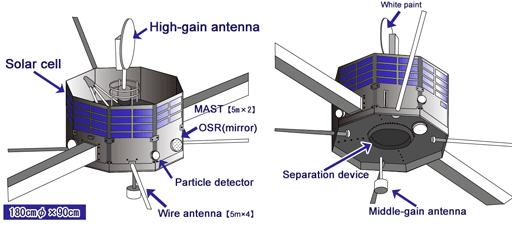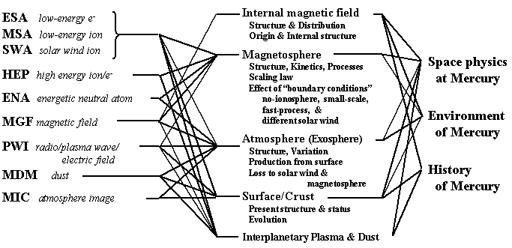|
|
|
|
|
MMO: Mercury Magnetospheric Orbiter |
Japanese page>> |
|
|
|
|
|
|
MMO (Mercury Magnetospheric Orbiter) : Objectives |
|
|
|
|
|
The MMO spacecraft mainly aims the study of the magnetic field and magnetosphere of Mercury.
JAXA/ISAS is responsible for its development and employment on the Mercury orbit.
Earth and Mercury have intrinsic magnetic field, but Mars and Venus do not. Why?
Comparison of the Mercury's magnetic field with Earth's
brings us the large step for the understanding of the terrestrial magnetic field and magnetosphere,
and the magnetospheres in the various scales in the Universe.
The main objectives of the MMO spacecraft are as follows:
- Structure and origin of Hermean magnetic field
The magnetic field around Mercury in high accuracy will be surveyed
for the study of the origin of planetary magnetic field.
- Structure, dynamics, and physical processes of Hermean magnetosphere
The magnetosphere will be surveyed in detail
for the investigation of the universality and the singularity of planetary magnetospheres.
- Structure, variation, and origin of Hermean exosphere
The large-scale structure and variation of the thin 'atmosphere' tell us
their generation / disappearance processes.
- Environment of inner solar system
The powerful environment near the sun is observed, and the energy process is solved.
|
|
|
|
|
|
|
|
|
|
|
|
MMO: Overview |
|
|
|
|
|
MMO is the 'Spin-type' spacecraft with the spin rate of 4 seconds.
This is because of the "3-dimensional velocity distribution of particles" and "extension of four long wire antennas (15m)
and two MASTs (5m) for electromagnetic field measurements with centrifugal force".
The spin axis is almost perpendicular to the Mercury equatorial plane.
This is 1) the rejection of solar reflection light into the upper / lower surface of the spacecraft and
2) the continuing aiming of the High-Gain antenna to the Earth with small efforts.
On the side panel, "SSM", a kind of mirror, is fully stuck in order to reflect the much intence sun light.
SSM reflects the optical light and emitts the infrared light, so that
the temperature inside the spacecraft is kept near 'the room temperature'.
(Normal operation of an electric device is not guaranteed at high temperature.)
|
|
|
|
|
|

|
|
|
|
|
|
The MMO spacecraft will enter to the polar orbit with "400km periheam and 12,000km apoherm",
in order to make magnetic field mapping of all spheres and observation of the Mercury magnetosphere in whole regions.
Orbital period is 9.2 hours.
This orbit has the same plane and and 4 times cycle (MPO:2.3 hour) of the MPO orbit,
and can perform cooperation observation with MPO easily.
In the cruise phase to Mercury,
MMO is carried with Mecury Composite System (MCS) under the control of ESA,
jointed with the MPO spacecraft and promotion modules.
After the arrival, the MMO will be separated by spin-ejection,
and be operated by Sagamihara Space Operation Centre in ISAS/JAXA
with UDSC 64m antenna in Nagano Japan.
|
|
|
|
|
|
|
MMO: Payload Selection |
|
|
|
|
|
Payloads for MMO and MPO spacecraft was selected by the international payload review comittee in fall 2004.
Now, several joint payload teams with Japanese and European scientists
actively make design and development efforts.
Moreover, the observation plan after the Mercury arrival will draw up and carry out by the
"BepiColombo Science Working Team" which involved in not only the payload development members
but also the theoretical researchers in both Europe and Japan.
((( MMO Science Working Sub-Group: Payload Teams )))
|
|
|
|
|
|
Name
(member) |
Target |
PI and Co-PIs |
Other Institutions |
MGF
(35) |
magnetic field |
W. Baumjohann (IWF, Austria)
A. Matsuoka (ISAS/JAXA) |
Japan: Tokai Univ., Kyushu Univ., Tohoku Inst. Tech.,
Kumamoto Univ., Tokyo Inst. Tech., Univ. Tokyo, NiCT
Europe:Tech. Univ. Braunschweig (Germany)
Imperial College (UK)
Others:APL/JHU, UCLA (USA)
|
MPPE
(65) |
low / high energy
electrons / ions,
energetic neutrals |
Y. Saito (ISAS/JAXA)
J.-A. Sauvaud (CESR-CNRS, France)
M. Hirahara (Rikkyo Univ.)
S. Barabash (IRF, Sweden) |
Japan: Kyoto Univ., STEL/Nagoya Univ.,
Tokyo Inst. Tech., Tohoku Univ., Univ. Tokyo,
NIPR, NiCT
Europe:
CETP-IPSL, CNRS (France),
MSSL/UCL (UK),
CNR-IFSI (Italy),
Charles Univ., IAP (Czech),
BIRA-IASB (Belgium),
MPS (Germany)
Univ. Bern (Switzerland)
Others: Boston Univ. (USA), National Central Univ. (Taiwan)
|
PWI
(45) |
electric field,
plasma wave,
radio wave |
Y. Kasaba (Tohoku Univ.)
J.-L. Bougeret (LESIA, France)
L. Blomberg (Alfven Lab., KTH, Sweden)
H. Kojima (RISH, Kyoto Univ.)
S. Yagitani (Kanazawa Univ.) |
Japan: Toyama Pref. Univ., Ehime Univ.,
Kyoto Sangyo Univ., ISAS/JAXA
Europe:
LPCE-CNRS, CETP-IPSL (France),
IRF (Sweden),
Univ. Oslo (Norway),
Finn. Meteo. Inst.,
Univ. Oulu (Finland),
Eotvos Univ. (Hungary),
ESA/RSSD
|
MSASI
(20) |
spectroscopic
image (Na line) |
I. Yoshikawa (Univ. Tokyo)
O. Korablev(IKI, Russia) |
Japan: Rikkyo Univ., Tohoku Univ.,
Tokyo Polytech. Univ., NIPR, JAXA
|
MDM
(12) |
dust count/moment |
H. Shibata (Kyoto Univ.) |
Japan:
Tokyo Univ. Marine Sci. Tech.,
Waseda Univ., Osaka City Univ., NAO, ISAS/JAXA
Europe:
MPI-NP (Germany)
|
<<< MMO model payloads: basis for the project start in 2004 >>>

MMO:Payload (2010/11)
Mercury Plasma Particle Experiment
(MPPE) |
Mercury Electron Analyzer (MEA) |
Low-energy electrons |
3eV-30keV, dt=1sec |
| Mercury Ion Analyzer (MIA) |
Low-energy ions |
5eV-30keV, dt=2sec |
| Mass Spectrum Analyzer (MSA) |
Ion Mass |
5eV-40keV, dt=2sec |
| High-Energy Ions (HEP-ion) |
High energy Particle-Ions |
30keV-1MeV,
dt=4sec |
High-Energy
Electrons
(HEP-ele) |
High energy Particle-electrons |
30keV-700keV,
dt=4sec |
Energetic Neutrals
Analyzer (ENA) |
High-energy Neutral Atoms |
<25eV-3.3keV,
dt=80sec |
| Magnetic Fierld Investigation (MGF) |
Magnetic field |
DC-64Hz |
| Plasma Wave Investigation (PWI) |
Electric Field, Plasma wave, Radio wave |
DC-10MHz(E)
Few-640kHz(B) |
| Mercury Sodium Atomosphere Spectral Imager (MSASI) |
Na-atmosphere image |
FOV:-30deg |
| Mercury Dust Monitor (MDM) |
Interplanetary Dust |
PZT |
|
|
|
|
|
|
|
|
|
|
|
BepiColombo : Spacecraft |
|
|
|
|

